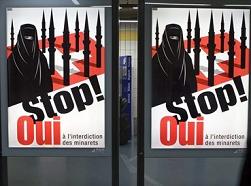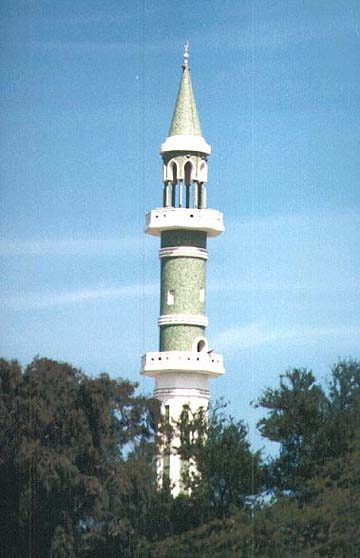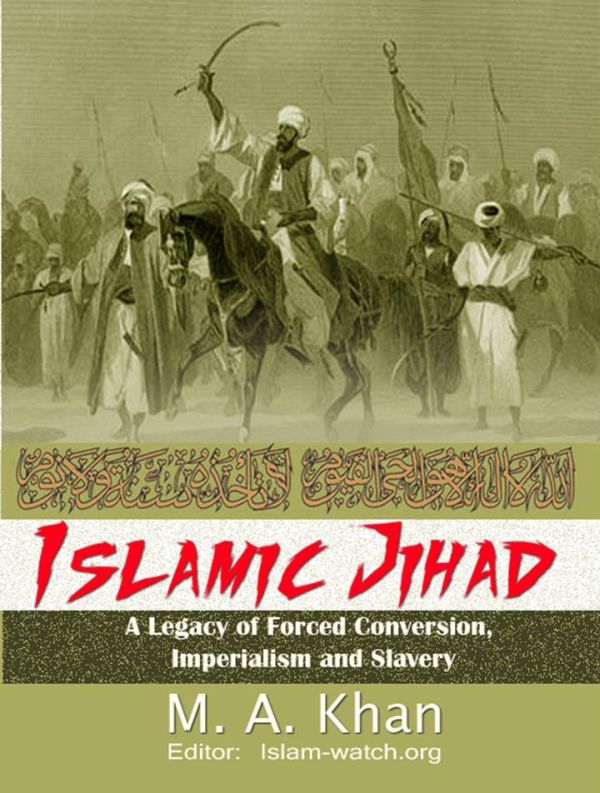Turkey's Islamist Prime Minister Erdogan recited in 1998 that 'minarets are our bayonets', and the Swiss voters banned minarets in Switzerland in a 30 November 2009 referendum, claiming that it's a symbol of Islam's political domination. Both Erdogan and Swiss voters are right. Moreover, minarets are not Islamic, indeed anti-Islamic, and borrowed from Christianity...
 Swiss voters banned minarets |
In a public gathering in 1998, Recep Tayyip Erdogan, leader of the ruling Islamist party and current Prime Minister of Turkey, recited: "The mosques are our barracks, the domes our helmets, the minarets our bayonets and the faithful our soldiers..."
These words earned him a conviction and minor jail-term for inciting religious hatred.
Taken from Erdogan’s recitation or not, the phrase, minarets our bayonets, it appears, has caught the Swiss with alarm amidst its rising Muslim populations. In a referendum on Sunday, 29 November 2009, some 58% of Swiss voters backed a ban of minarets on mosque-tops in Switzerland on the ground that it’s a symbol of political domination in Islam, which threatens the secular nature of the Swiss society, since there is no separation of religion and politics in Islam.
The backing of the referendum—initiated by right-wing parties, but condemned by the government, major political parties, media and intellectuals, even outside of Switzerland—surprised observers, including initiators of the move, because opinion polls, days earlier, showed only 34% of the voters would back the motion.
Quite understandably, passing of the referendum has caused global uproar and flurry of condemnations. There has been threat of boycott of Swiss products by Islamic countries to hauling the Swiss government before the European Commission and the UN, because legislating the ban would amount to denial of freedom of religion to Muslims.
The backers of the move were quick to reassure Muslims of their religious freedom in Switzerland. Said one activist behind the move, "…this will in no way change their [Muslims’] right to practise their religion, to pray or to gather [in mosques]… However, society wants to put a safeguard on the political-legal wing of Islam, for which there is no separation between state and religion".
While much has been said about the referendum, this article will focus on what minarets represent in Islam, religiously and historically. In other words: Are minarets a symbol of ‘political domination’ or the ‘bayonets’ of Islam?
Origin: Not at all Islamic but Christian
 Minarets on Christian Churches |
Whatever it represents, the bayonet-shaped minarets have become a proud and exclusive symbol of Islam today. Yet, minarets are, fundamentally, neither Islamic nor an innovation of Islam.
Going back to Prophet Muhammad—who basically founded a monotheistic religion, Islam, for the Bedouin desert Arabs, never dreaming it would ever spread out of the Arab Peninsula—he himself had no conception of minarets; he would have duly rejected such sumptuous structures on mosque-tops or attached to them.
Fitting for a desert Prophet and the prevailing sociopolitical situation and institutions, Muhammad founded a creed, perfect for the underdeveloped desert Arab Bedouins. He opposed creating buildings on a grand scale, saying that “Truly the most unprofitable thing that eats the wealth of a believer is building” and that “Every expense of the believer will be rewarded except the expense of the building”.
And, despite founding a powerful Islamic state, poised to dominate the world in the next two decades, the two early mosques founded by Muhammad, one in Koba and the Prophet’s mosques in Medina, were simple structures until his death. Rain leaked through the roof of his ramshackle mosque in Medina. And when a companion asked if it should be repaired, Muhammad answered: “No, a mosque should be simple and modest, a booth, like the booth of Moses.”
Obviously, such structures, as approved by the prophet as mosques, could not even hold minarets on their tops. The idea of minarets never crossed Muhammad’s mind. And for eight decades after Muhammad’s death, minarets were not a part of mosques.
Minarets became a part of mosques in the period of the “Godless” Umayyad dynasty that came to power by ousting the Prophet’s grandson Hasan (661 CE), and later exterminating the Prophet’s offspring, including his other grandson Husayn, a pretender to the caliphate (Battle of Karbala, 680 CE). The Godless Umayyads first introduced the tradition of building gorgeous architectural and building structures, including elegant mosques, defying prior tradition and pious Islamic injunctions against it.
 Islamic Minarets borrowed from Christianity |
Umayyad Caliph al-Walid I (r. 695–715) was the first to introduce minarets to mosques, emulating the steeple, a bell-tower structure that was a feature of Christian churches. This move faced strong resistance from the pious, who objected to constructing anything higher than walls of the mosque. They also condemned the rulers for incorporating Christian symbols to sacred mosques.
Minarets have undergone refinement, becoming a gorgeous architectural symbol of Islam, but it is obviously not Islamic; in fact, it is anti-Islamic and borrowed from Christianity. It’s a Christian religious symbol in its originality. Even the term mosque, masjid in Arabic, is also usurped from Christianity; it is an Arabic rendering of the Aramaic term masgeda, then in Christian usage, meaning their ‘place of worship’.
What does a minaret represent?
To most observers, minarets would appear as a simple religio-architectural symbol, having nothing to do with ‘political power’, opposed to what Erdogan and the Swiss voters would have us believe. But minarets have a political dimension, at least, from the viewpoint of its origin and history.
After knocking out the world’s second-greatest power, Persia and capturing Central Asia and North Africa, the Umayyads—despite gaining considerable grounds in the Christian East and later in Spain—remained horn-locked in an impossible, and often disastrous, battle with Christian Byzantium as well as Christian Europe. For many centuries, the Christian world remained the enemy par excellence of Islam. Islam’s mission of global conquest, initiated by Muhammad, was persistently held back by Christian Europe, despite slowly losing grounds, before attaining supremacy over the Islamic Jihadis and beating them back, and even going on to capture most of the Islamic lands in the so-called Colonial Age.
Only after the Umayyads turned Islam into the master world-power, they started building imposing structures—initially in the form of sumptuous palaces, to which gorgeous mo mosques, minarets and mausoleums were added later on—all over the conquered lands (although clearly prohibited by Muhammad and the Quran) so as to declare the religious and political supremacy of Islam.
As concerns introduction of minarets, its beginning was, in fact, an act of borrowing the icon from Christian religious structures and using it to declare Islam’s supremacy over Christianity, the arch-enemy of Islam. And there was no better place of doing it than in Palestine, the holiest land of Christianity and the birthplace of Jesus. Here, al-Walid I, in 712, constructed first gorgeous mosque, the al-Aqsa mosque, fitted with a dome (of central Asian origin). The dome was constructed using remains of a destroyed church in Asia Minor. Thereafter, minarets began to be added on mosque-tops all over the world.
Hereon, wherever Muslims has gone, mosques, fitted with imposing domes and minarets, became the feature of all political centers of Islam, from India to Spain to Constantinople, declaring the supremacy of Islam and Muslims over non-Muslims. Indeed, building gorgeous mosques with minarets often became the first building initiative, which Islamic conquerors undertook in the newly conquered lands. For example, in India, the construction of the famed Quwat-al-Islam (Might of Islam) Mosque and the Qutb Minar (minaret) in Delhi were undertaken by Islamic conquerors in the 1190s, well before the founding of the permanent Muslim Sultanate in 1206.
Sky-piercing minarets, thus, became the familiar icon of the seats of Islamic power throughout history. Istanbul—the captured heartland of eastern Christianity Constantinople, which became the indomitable powerhouse of the Islamic Ottomans that terrorized Christian Europe for centuries—is also dotted the world’s finest minarets, an indication of what Istanbul stood for in the Islamic world. Erdogan, a well-versed Islamist ideologue, could hardly be wrong: Minarets are the ‘bayonets’, the symbol of Islam’s power.
Minarets represent a declaration not only of ‘who is in power’, but also of the supremacy of the Islamic creed. It is from here the residents, Muslim or non-Muslim, would be reminded, one likes it or not, in ear-blaring loudness five times a day that Islam is in power, that Islam calls the shot, that Islam is your ultimate choice. It’s not only a call to prayer to the faithful, but also a call to the infidels for the submission to Islam, five times daily, however irritating it may be.
If one has traveled in Asia, he/she would find that, even in the predominantly infidel cities in India, in Singapore, where Islam has been dislodged from power, thanks to British colonial interventions to some extent, but the people, overwhelmingly non-Muslim, must have to bear with the reminder for submission to Islam five times a day, including the most irritating wee-hour call to prayer.
Islamic power has gone from these lands, but the symbol remains. And, given the high breeding rates amongst Muslims, it also amounts to sign of the things to come again: absence of Islam’s hold on power in these lands is not permanent.
The Swiss minaret ban has drawn epithets such as shame, disgrace, Swiss racism, victory of Islamophobia, illiberal decision and so on for the nation. But the Swiss have obviously got it right in taking Erdogan’s message seriously: Minarets are Islam’s symbol of political domination.
Muslims are the fastest-rising populations in Western countries, with increasing Islamic orthodoxy and radicalism. The Islamic world, somewhat secularized in the Colonial Age and by the western influence of socialism/communism in the early 20th century, is witnessing increasing political integration of Islam, too. It is people like Erdogans, who want to turn minarets into bayonets of Islam, get unrivalled political backing from Muslims. Given these fact, the Swiss, indeed the wider secular West, has much to ponder when those lands are poised to witness Muslim dominance in a century, if not in a half.
Muslim immigrants in Europe today may acquiesce to not using minarets for ear-blaring calls to prayers five times a day as the Swiss Muslims have promised. But that’s what is minarets are meant for, and they would be bidding for time: first for being able to use minarets for the loud calls to prayer, and eventually for turning them into the bayonets of Islam by introducing Sharia in the West, something they have been strenuously striving for even at this stage.
M. A. Khan is author of Islamic Jihad: A Legacy of Forced Conversion, Imperialism and Slavery, and the editor of islam-watch.org.



Comments powered by CComment